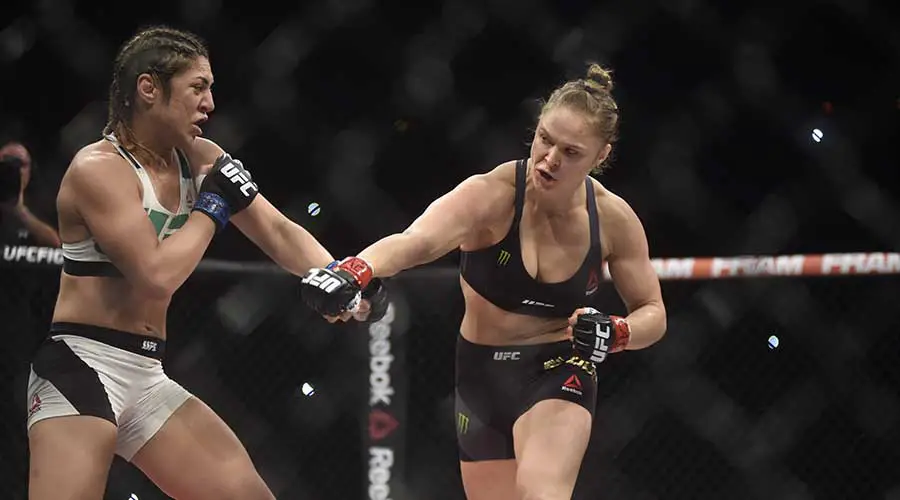Mixed martial arts, also known as MMA, has emerged as a global phenomenon, winning fans and practitioners all over the world.
From the “vale-tudo” fights created by the Gracie family to the professionalisation of the sport, the sport has become competitive.
As a direct consequence, several tournaments, both national and international, began to spring up in various countries.
MMA then became a profession as well as entertainment for those who love fighting, offering explosive, action-packed combats.
In this complete and up-to-date guide, you’ll learn about the fascinating history of mixed martial arts, find out about the different categories that make up this unique sport and learn about its close relationship with the UFC.
Check it out 👇
What is MMA?
MMA, which stands for mixed martial arts, is a form of sporting competition that involves the use of various fights and combat techniques, such as boxing, jiu-jitsu, judo and muay thai.
In tournaments, therefore, participants are allowed to use both contact blows and ground fighting techniques, which results in dynamic, diverse, strategic and extremely physical confrontations.
Despite this freedom, there are specific rules governing the fights. They define what can be done and what is forbidden in fights.
The aim of MMA matches is to overcome the opponent, either by knocking them out or by winning the match by judges’ decision. To do this, the fighters exchange blows in rounds with a duration pre-established by the competition.
MMA origins

Although there are reports of similar fights in Ancient Greece, MMA as it is known today was created by the Brazilian Gracie family in the 1920s.
Back then, patriarchs Carlos and Hélio organised fights between practitioners of various martial arts. The aim was to show that the jiu-jitsu developed by the family was capable of beating other disciplines.
In the beginning, the fights had no time limit and were held in the “vale-tudo” format, i.e. without many restrictions on blows and techniques.
The fights became so famous that they began to gain fans in several countries, especially the United States. It was there that the Ultimate Fighting Championship (UFC) was created in November 1993.
Rorion Gracie, Art Davie, Bob Meyrowitz, Campbell McLaren and John Milius are considered the founders of the event, which became the most important in the segment and helped MMA become popular in the rest of the world.
Over the years, MMA has evolved into a highly regulated form of competition, incorporating elements of various martial arts and gaining international acceptance as a legitimate sport.
Nowadays, the competitive scene includes tournaments other than the UFC, such as Bellator, the Professional Fighters League and One Championship.
MMA rules
The unified rules of MMA have been developed to provide a safe, fair and equitable environment for fighters, as well as guaranteeing the integrity and quality of fights.
The rules may vary slightly between organisations, but the guidelines established by the State Athletic Commissions and other regulatory bodies generally follow a common structure:
- Rounds | Fights are divided into rounds, usually five minutes each, with rest breaks in between;
- Weight categories | Athletes compete in specific weight categories to ensure fairness and safety;
- Illegal blows | Illegal techniques include blows to the back of the head, the eyes, the throat, the groin, the spine and elbows from above;
- Grabbing and holding | Fighters can use grabbing techniques, such as wrestling and judo, but the referee can interrupt the fight if he considers that the participants are not making progress;
- Submissions | Submission techniques such as chokes and arm and leg locks are permitted. The opponent, therefore, can give up by patting the octagon, as happens in boxing;
- Equipment | Athletes must wear appropriate protective equipment, such as gloves and mouthguards;
- Refereeing | A referee supervises the fight and can stop it if he deems it necessary. Victory decisions can be made based on the rounds and scoring criteria, including effectiveness of blows, control of the fight and aggressiveness.
How do you win an MMA fight?

In MMA, a victory can be declared in various ways. The most common are: when a fighter hits the ground indicating that he can no longer continue or when a referee decides that the fighter is not fit to continue fighting, whether due to technical knockouts, fainting or similar situations.
A victory can also be declared: when the coach throws in the towel in the octagon, when the bleeding from an injury is not stopped, when a fighter violates the rules of the competition or when time runs out.
In the latter case, the referees decide who the winner will be, using evaluation criteria such as the effectiveness of the blows, control of the fight and aggressiveness.
Which blows are not allowed in MMA?
- Blows to the eyes
- Blows to the spine
- Blows to the back of the head
- Blows to the throat
- Blows to the groin
- Blows with outstretched fingers
- Knee to the head of a fallen opponent
- Kicking a fallen opponent in the head
- Stepping on a fallen opponent
- Elbows from above
- Pulling hair
- Biting the opponent
- Spitting on the opponent
- Headbutting
- Putting your finger in your opponent’s mouth or nose
- Holding the opponent’s glove
- Grabbing the opponent’s shorts
- Throwing the opponent out of the octagon
- Intentionally avoiding contact
Throwing illegal blows or techniques can result in points being deducted or, in very serious situations, even in the fighter being disqualified. These decisions are made by the referees who conduct the fights.
What are the weight categories in MMA?

- Strawweight | Up to 52.2 kg
- Flyweight | Up to 56.7 kg
- Bantamweight | Up to 61.2 kg
- Featherweight | Up to 65.8 kg
- Lightweight | Up to 70.3 kg
- Super Lightweight | Up to 74.8 kg
- Welterweight | Up to 77.1 kg
- Super Welterweight | Up to 79.4 kg
- Middleweight | Up to 83.9 kg
- Super Middleweight | Up to 88.5 kg
- Light Heavyweight | Up to 93 kg
- Cruiserweight | Up to 102.1 kg
- Heavyweight | Up to 120.2 kg
- Super Heavyweight | No limit
The categories were created with the aim of providing fairer fights. Before the fights, the participants are weighed to find out if they are within the limit. If so, the match takes place.
What is MMA equipment?
In MMA fights, it is compulsory to wear some equipment, such as gloves that leave your fingers free, mouthguards, genital protectors and some kind of clothing, usually shorts and tops (women).
There is also equipment that is considered optional, such as knee pads, elbow pads, bandages and Vaseline (only on the face).
What is the difference between MMA and UFC?
MMA (mixed martial arts) is a sport. In the other hand, UFC is a championship made up of MMA events.
Now you know all about mixed martial arts and are ready to follow the main championships, such as the UFC. Visit us every day for more fresh content on sports, games and betting 👊



